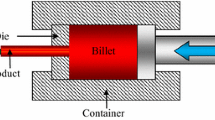Abstract
A new approach to the optimal design of the die wall temperature profile in polymer extrusion processes is presented. In this approach, optimization of the design variables is conducted by a Response Surface Method (RSM) and the Sequential Quadratic Programming (SQP) algorithm. Design of experiment (DoE) needed for the construction of the response surface is used to evaluate the objective and the constraint functions on the basis of a finite element method (FEM). Two designs of experiments are used and the performances of the optimization results are compared with respect to efficiency and ability to obtain a global optimum. Typically, for extrusion die design, the objective function states that the average velocity across the die exit is uniform. Constraints are used to limit the pressure drop in the die. For this purpose, we optimize the wall temperature profile of a coat hanger die in a heterogeneous way, (i.e. the wall temperature may not be constant in the entire die). The melt temperature enables us to locally control the viscosity, which influences the flows in the various zones. The effect of the design variables in the objective and constraint functions is investigated using Taguchi method. The flow analysis results are then combined with an automatic optimization algorithm to provide a new profile of the die wall temperature distributions.
















Similar content being viewed by others
References
Nóbrega JM, Carneiro OS, Pinho FT, Oliveira PJ (2004) Flow balancing in extrusion dies for thermoplastic profiles. Int Polym Process 19:225–235
Ettinger HJ, Sienz J, Pittman JFT, Polynkin A (2004) Parameterization and optimisation strategies for the automated design of U PVC profile extrusion dies. Struct Multidisc Optim 28:180–194
Michaeli W, Kaul S, Wolff T (2001) Computer aided optimisation of extrusion dies. J Polym Eng 21:225–237
Lebaal N, Schmidt F, Puissant S, Schlafli D (2009) Design of optimal extrusion die for a range of different materials. Polym Eng Science 49:432–440
Smith DE (2003) An optimisation-based approach to compute sheeting die designs for multiple operating conditions. SPE ANTEC Tech. Papers, 315–319
Wang Y (1991) The flow distribution of molten polymers in slit dies and coat hanger die through three-dimensional finite element analysis. Polym Eng Sci 31:204–212
Vergnes B, Saillard P, Agassant JF (1984) Non-isothermal flow of a molten polymer in a coat-hanger die. Polym Eng Science 24:980–987
Schläfli D (1995) Analysis of polymer flow through coat-hanger melt distributors. Int Polym Process 10:195
Vergnes B, Agassant JF (1995) Modélisation des écoulements dans les filières d’extrusion. Techniques de l’Ingénieur, traité Plastiques et Composites, A3 655:1–19
Fradette L, Tanguy PA, Thibault F, Sheehy P, Blouin D, Hurez P (1995) Optimal-design in profile extrusion calibration. J Polym Eng 14:295–322
Myers RH, Montgomery DC (2002) Response surface methodology, process and product optimization using designed experiments, second editionth edn. Wiley interscience publication, USA
Montgomery DC (2005) Design and analysis of experiments. John wiley & Sons, INC, USA
Lebaal N, Puissant S, Schmidt FM (2005) Rheological parameters identification using in-situ experimental data of a flat die extrusion. J Materials Process Tech 164:1524–1529
Kaymaz I (2005) Application of Kriging method to structural reliability problems. Struct Safety 27:133–151
Lebaal N, Schmidt F, Puissant S (2009) Design and optimization of three dimensional extrusion dies, using constraint optimization algorithm. Finite Elem Anal Des 45:333–340
Author information
Authors and Affiliations
Corresponding author
Rights and permissions
About this article
Cite this article
Lebaal, N., Puissant, S. & Schmidt, F. Application of a response surface method to the optimal design of the wall temperature profiles in extrusion die. Int J Mater Form 3, 47–58 (2010). https://doi.org/10.1007/s12289-009-0416-x
Received:
Accepted:
Published:
Issue Date:
DOI: https://doi.org/10.1007/s12289-009-0416-x



